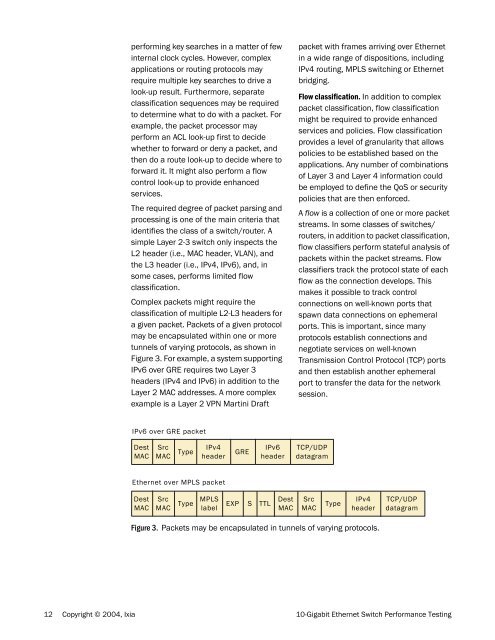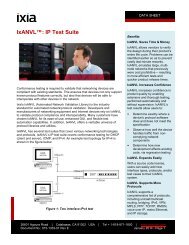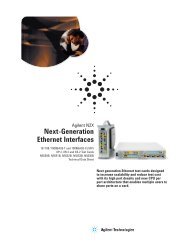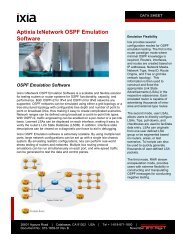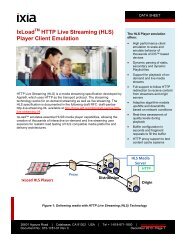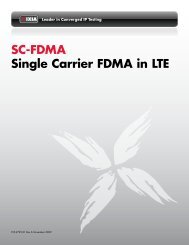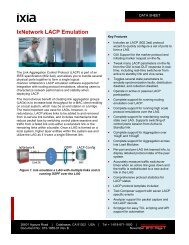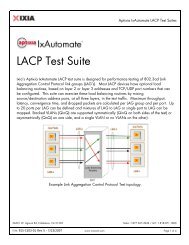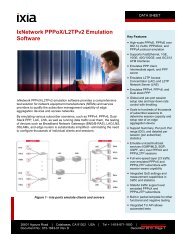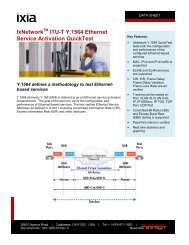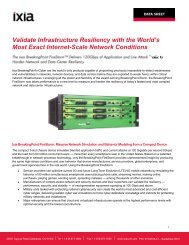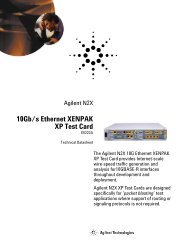10-Gigabit Ethernet Switch Performance Testing - Ixia
10-Gigabit Ethernet Switch Performance Testing - Ixia
10-Gigabit Ethernet Switch Performance Testing - Ixia
You also want an ePaper? Increase the reach of your titles
YUMPU automatically turns print PDFs into web optimized ePapers that Google loves.
performing key searches in a matter of few<br />
internal clock cycles. However, complex<br />
applications or routing protocols may<br />
require multiple key searches to drive a<br />
look-up result. Furthermore, separate<br />
classification sequences may be required<br />
to determine what to do with a packet. For<br />
example, the packet processor may<br />
perform an ACL look-up first to decide<br />
whether to forward or deny a packet, and<br />
then do a route look-up to decide where to<br />
forward it. It might also perform a flow<br />
control look-up to provide enhanced<br />
services.<br />
The required degree of packet parsing and<br />
processing is one of the main criteria that<br />
identifies the class of a switch/router. A<br />
simple Layer 2-3 switch only inspects the<br />
L2 header (i.e., MAC header, VLAN), and<br />
the L3 header (i.e., IPv4, IPv6), and, in<br />
some cases, performs limited flow<br />
classification.<br />
Complex packets might require the<br />
classification of multiple L2-L3 headers for<br />
a given packet. Packets of a given protocol<br />
may be encapsulated within one or more<br />
tunnels of varying protocols, as shown in<br />
Figure 3. For example, a system supporting<br />
IPv6 over GRE requires two Layer 3<br />
headers (IPv4 and IPv6) in addition to the<br />
Layer 2 MAC addresses. A more complex<br />
example is a Layer 2 VPN Martini Draft<br />
IPv6 over GRE packet<br />
Dest<br />
MAC<br />
Dest<br />
MAC<br />
Src<br />
MAC Type<br />
Src<br />
MAC<br />
IPv4<br />
header<br />
<strong>Ethernet</strong> over MPLS packet<br />
Type MPLS<br />
label<br />
GRE<br />
IPv6<br />
header<br />
EXP S TTL Dest<br />
MAC<br />
packet with frames arriving over <strong>Ethernet</strong><br />
in a wide range of dispositions, including<br />
IPv4 routing, MPLS switching or <strong>Ethernet</strong><br />
bridging.<br />
Flow classification. In addition to complex<br />
packet classification, flow classification<br />
might be required to provide enhanced<br />
services and policies. Flow classification<br />
provides a level of granularity that allows<br />
policies to be established based on the<br />
applications. Any number of combinations<br />
of Layer 3 and Layer 4 information could<br />
be employed to define the QoS or security<br />
policies that are then enforced.<br />
A flow is a collection of one or more packet<br />
streams. In some classes of switches/<br />
routers, in addition to packet classification,<br />
flow classifiers perform stateful analysis of<br />
packets within the packet streams. Flow<br />
classifiers track the protocol state of each<br />
flow as the connection develops. This<br />
makes it possible to track control<br />
connections on well-known ports that<br />
spawn data connections on ephemeral<br />
ports. This is important, since many<br />
protocols establish connections and<br />
negotiate services on well-known<br />
Transmission Control Protocol (TCP) ports<br />
and then establish another ephemeral<br />
port to transfer the data for the network<br />
session.<br />
TCP/UDP<br />
datagram<br />
Figure 3. Packets may be encapsulated in tunnels of varying protocols.<br />
12 Copyright © 2004, <strong>Ixia</strong> <strong>10</strong>-<strong>Gigabit</strong> <strong>Ethernet</strong> <strong>Switch</strong> <strong>Performance</strong> <strong>Testing</strong><br />
Src<br />
MAC<br />
Type<br />
IPv4<br />
header<br />
TCP/UDP<br />
datagram


